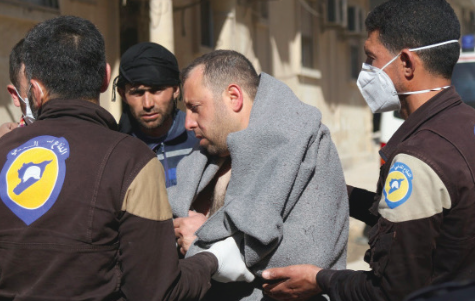Syrian Nerve Gas Attack Claims Over 70 Lives
The father cradled his nine-month-old twins, Aya and Ahmed, each in an arm. He stroked their hair and choked back tears, mumbling, “Say goodbye, baby, say goodbye,” to their lifeless bodies.
On April 4, Abdel Hameed Alyousef lost his two children, his wife and other relatives in the suspected chemical attack in the northern Syrian town of Khan Sheikhoun that killed at least 72 people. Alyousef sat in the front seat of a van with the twins, his eyes red as he asks his cousin Alaa to video his farewell to them.
The Trump administration and other world leaders said the Syrian government was to blame, but Moscow, a key ally of President Bashar Assad, said the assault was caused by a Syrian air strike that hit a rebel stockpile of chemical arms. Diplomats at the U.N. Security Council sparred over whether to hold President Assad’s government responsible for a chemical weapons attack that killed more than 70 people in northern Syria, while U.S. intelligence and the U.N. health agency said evidence pointed to nerve gas exposure.
The magnitude of the attack was reflected in the images of the dead civilians and children piled in heaps for burial. Medical teams also reported smelling bleach on survivors of the attack, suggesting chlorine gas was also used, Doctors Without Borders said.
President Trump responded with this statement: “The chemical attack in Syria against innocent people, including women and children, is reprehensible and cannot be ignored by the civilized world. These heinous actions by the Bashar al-Assad regime are a consequence of the past administration’s weakness.”
In Khan Sheikhoun, rescue workers found terrified survivors still hiding in shelters as another wave of airs trikes battered the town the next day. Those strikes appeared to deliver only conventional weapons damage. The visuals from the scene were reminiscent of a 2013 nerve gas attack on the suburbs of Damascus that left hundreds dead.
That attack prompted an agreement brokered by the U.S. and Russia to disarm Assad’s chemical stockpile. Western nations blamed government forces for that attack, where effects were concentrated on opposition-held areas.
At the United Nations, U.S. Ambassador Nikki Haley warned that the Trump administration would take action if the Security Council did nothing in response to the attack. Following that statement, on April 7, the U.S. fired 59 cruise missiles on a Syrian airfield directed against Islamic State’s operations base. As a precaution, the Pentagon is flying patrols in Syrian skies with F-22 jets, the Air Force’s most advanced air-to-air fighter.
“When you kill innocent children, innocent babies with a chemical gas that is so lethal, people were shocked to hear what gas it was, that crosses many, many lines,” said President Trump in the White House Rose Garden.
Mohammad Alloush, the rebels’ chief negotiator at U.N.-mediated talks with the Syrian government, said that the Syrian government of Assad was responsible for killing civilians.
“The true solution for Syria is to put Bashar Assad, the chemical weapons user, in court and not at the negotiations table.”
Syria’s rebels and the Islamic State’s Army are also accused of human rights abuses in Syria, but rights watchdogs attribute the overwhelming portion of civilian casualties over the course of the six-year war to actions of government forces and their allies.



